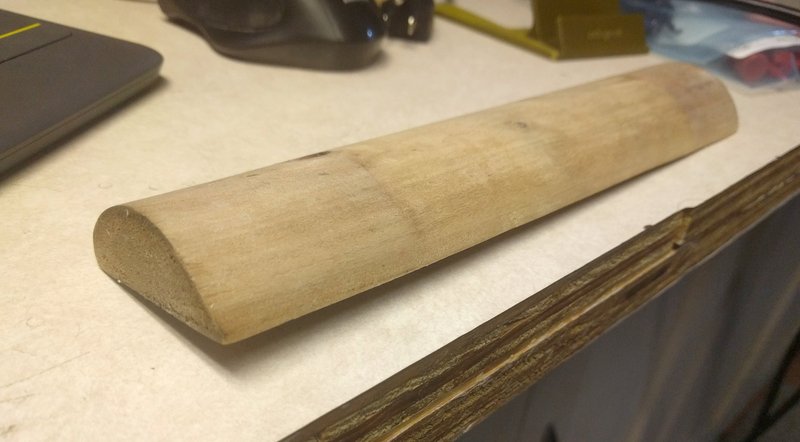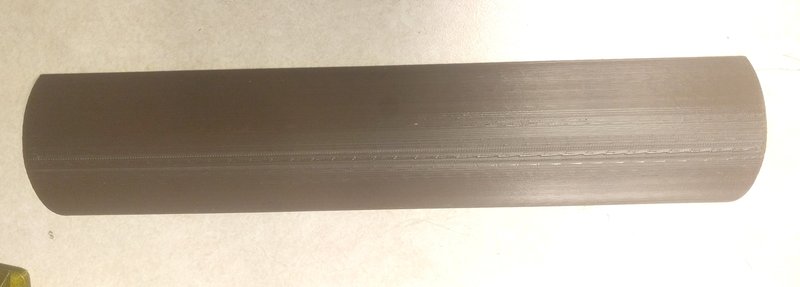Posts: 10
Threads: 0
Joined: Aug 2018
03-05-2021, 03:31 PM
(This post was last modified: 03-05-2021, 03:32 PM by criageek.)
I restore old radios and one that I'm working on has rounded trim pieces on each side of the front.
The one on the right was missing a chunk of veneer and the one on the left was badly twisted. I removed the original veneer and tried to straighten the one on the left by soaking it in water for about 2 weeks then clamping it for about 2 weeks. That didn't help...in fact I think it's worse that it was before.
So I printed new substrates for both sides on my 3d printer.
I was able to form some veneer (soak in water for a few days then clamp into a form that I printed on the 3d printer) and glue it to the right substrate using contact cement, but for some reason I keep having trouble forming the veneer for the left one...it keeps cracking.
It needs to be formed with the grain...if I could do it the other direction it would be no problem.
Any ideas how I can prevent the veneer from cracking when I bend it?
Thanks,
Rich
Posts: 13,166
Threads: 0
Joined: Jan 2010
Location: Lewiston, NY
03-05-2021, 05:01 PM
(This post was last modified: 03-05-2021, 05:03 PM by jteneyck.)
You don't need to soak it in water, you need to heat it like is done making shaker oval boxes. Look that up, you'll see. Once you get it formed to the approximate shape, you can glue it down but not with contact cement, use Titebond I or Plastic Resin Glue or epoxy. They are much stronger and won't let loose a year on. It would be very simple if you had a vacuum bag but short of that you could build a simple mold with the curved piece mounted on top of a couple of 2 x 8's etc, something just a little narrower than the curved piece. Then use a piece of canvas or heavy vinyl sheet to pull the veneer down over the curved piece and clamp it really well until the glue dries/cures, like 24 hours. With 20 or 30 mil clear sheet vinyl you can see what's happening while you do it to assure everything is done correctly. Trim the edges after the glue cures.
Considering your forms are plastic you should use Gorilla Glue or Epoxy.
John
Posts: 10
Threads: 0
Joined: Aug 2018
(03-05-2021, 05:01 PM)jteneyck Wrote: You don't need to soak it in water, you need to heat it like is done making shaker oval boxes. Look that up, you'll see. Once you get it formed to the approximate shape, you can glue it down but not with contact cement, use Titebond I or Plastic Resin Glue or epoxy. They are much stronger and won't let loose a year on. It would be very simple if you had a vacuum bag but short of that you could build a simple mold with the curved piece mounted on top of a couple of 2 x 8's etc, something just a little narrower than the curved piece. Then use a piece of canvas or heavy vinyl sheet to pull the veneer down over the curved piece and clamp it really well until the glue dries/cures, like 24 hours. With 20 or 30 mil clear sheet vinyl you can see what's happening while you do it to assure everything is done correctly. Trim the edges after the glue cures.
Considering your forms are plastic you should use Gorilla Glue or Epoxy.
John
Thanks John - I'll look that up!
Rich
Posts: 10
Threads: 0
Joined: Aug 2018
I did as little research on this but then it dawned on me that any method involving heat probably would not work for this. I print using PLA filament which I believe has a melting point of around 65 degrees C (149 F).
Rich
Posts: 168
Threads: 0
Joined: Feb 2019
What about the stuff they sell to flatten burls? That has some glycerin in it. You don't need to soak it just wet don the veneer then form it around you form.
Posts: 10
Threads: 0
Joined: Aug 2018
(03-06-2021, 10:53 AM)CEPenworks Wrote: What about the stuff they sell to flatten burls? That has some glycerin in it. You don't need to soak it just wet don the veneer then form it around you form.
Thanks CEPenworks - I'm not a woodworker at all so don't know what that is. Can you point me at it or tell me what it's called?
Thanks!
Rich
Posts: 12,708
Threads: 0
Joined: Aug 2003
Location: Wapakoneta, OH
Use the heat trick and form the veneer on the old wooden form, then glue it to the plastic substitute you made. You won't get it exact on the old form, but it will be close enough to not crack (I hope/think).
I started with absolutely nothing. Now, thanks to years of hard work, careful planning, and perseverance, I find I still have most of it left.
Posts: 168
Threads: 0
Joined: Feb 2019
This is what I have used,
link. I am not promoting is as better or worse than any other product. I don't know if this will do what you need but it does soften the veneer.
Fred has a good suggestion about heating it and using your wood mold to bend then glue to your plastic one. You are going to need to balance moisture and time to get the veneer to stick but not mold. Usually with a vacuum bag you press for an hour or so to get the glue to set then take it out so the glue can dry. If you wrap the project in a plastic to hold it while gluing remove the plastic after the glue has had time to set.
Posts: 13,166
Threads: 0
Joined: Jan 2010
Location: Lewiston, NY
03-06-2021, 07:09 PM
(This post was last modified: 03-06-2021, 07:12 PM by jteneyck.)
(03-06-2021, 10:39 AM)criageek Wrote: I did as little research on this but then it dawned on me that any method involving heat probably would not work for this. I print using PLA filament which I believe has a melting point of around 65 degrees C (149 F).
Rich
You misunderstood how it works. You use heat to pre bend the veneer over a heated pipe until it approximates the shape of your curved plastic substrate. Then you glue the room temperature veneer onto the plastic substrate.
Or do it in hot water like this:
Link
John
Posts: 10
Threads: 0
Joined: Aug 2018
03-07-2021, 08:49 AM
(This post was last modified: 03-07-2021, 08:50 AM by criageek.)
Thanks guys - I appreciate all the input

I'll let you know what I end of doing. Before I created this thread I had already cut another piece of veneer and put it in a bucket of water, so it's been in there a couple of days now. Maybe I'll fill the sink with hot water and let it soak in that for a few minutes, then try to form it.
Thanks for the video link John, that was actually the first video I came across when I started researching

Rich

















 I'll let you know what I end of doing. Before I created this thread I had already cut another piece of veneer and put it in a bucket of water, so it's been in there a couple of days now. Maybe I'll fill the sink with hot water and let it soak in that for a few minutes, then try to form it.
I'll let you know what I end of doing. Before I created this thread I had already cut another piece of veneer and put it in a bucket of water, so it's been in there a couple of days now. Maybe I'll fill the sink with hot water and let it soak in that for a few minutes, then try to form it.